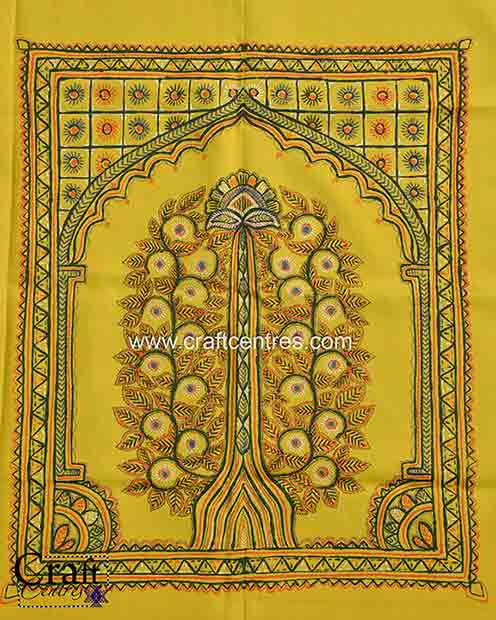Rogan Art by Asmita Soni Preserving and Innovating
Honoring Asmita Soni: The Torchbearer of Rogan Art
Nestled in Moti Virani, Nakhtrana, Kutch, Asmita Soni shines as a trailblazer in the world of Rogan art. As the woman from her region to master this ancient craft, Soni is dedicated to ensuring that this centuries-old tradition continues to thrive in the modern age.
Rogan Painting: A Timeless Art Form

Rogan painting, a cherished craft from Gujarat, India, is more than just an art form; it is a living piece of cultural history. Dating back approximately 1600 years, Rogan painting is notable for its use of natural oils and pigments to create elaborate, colorful patterns on fabric. What sets Rogan art apart is its freehand method: designs are applied to one side of the fabric and then transferred to the other side by folding the cloth.
Traditionally, Rogan artists use a palette of just five colors—orange, blue, yellow, green, and white. Despite this limited range, the art form is known for its vibrant, complex designs, showcasing the artist’s remarkable ability to manipulate a few hues to create stunning patterns.

Asmita Soni: A Modern Master of Rogan Art
Asmita Soni’s journey into the world of Rogan art is both inspiring and groundbreaking. Under the guidance of her brother, Ashish Kansara, Soni has not only embraced this traditional craft but has also emerged as a leading figure in its preservation and evolution. Over the past five years, she has dedicated herself to mastering and promoting Rogan art, becoming the only female artist in India to continue this ancient tradition.
Her work includes captivating pieces such as the “Tree of Life” Rogan painting, which highlights her expertise and dedication. This piece exemplifies the intricate beauty of Rogan art while reflecting her unique artistic vision. Soni’s contributions are vital in keeping Rogan art relevant and appreciated in today’s fast-paced world.

The Artistry Behind Rogan Painting
Creating a Rogan painting involves a fascinating and meticulous process. The artist starts by making a paste from natural oils and pigments, which is then applied to the palm of the hand. Using an iron rod, the artist carefully transfers the paste onto the fabric in a freehand design. This technique requires immense skill and precision, as the design is mirrored by folding the fabric and pressing it to ensure that both sides align perfectly.
Once the design is applied, the fabric is left to dry in the sun. This crucial step sets the colors and ensures the painting’s durability and vibrancy. The entire process demonstrates a deep understanding of both materials and techniques, showcasing the artist’s mastery of this ancient craft.
Rogan Art by Asmita Soni | Preserving and Innovating
Asmita Soni’s dedication to Rogan art goes beyond merely preserving tradition; it involves innovating within it. By refining traditional techniques and embracing new ideas, she ensures that Rogan art continues to resonate with contemporary audiences while honoring its historical roots. Her efforts are essential in preserving this cultural heritage and keeping it vibrant and relevant.
Artists like Soni play a crucial role in keeping ancient crafts alive. In a world dominated by modern technology and mass production, her work serves as a bridge between the past and the present. Through her art, Soni not only celebrates a rich cultural tradition but also inspires future generations to appreciate and continue these invaluable practices.

The Wider Impact
Asmita Soni’s contributions extend beyond the art world. Her commitment to Rogan painting underscores the importance of preserving cultural heritage and traditional skills. As the only female Rogan artist in India, her work highlights the significant role of women in sustaining and advancing cultural traditions.
Moreover, Soni’s efforts draw attention to the global significance of ancient crafts. The recognition of Rogan art in Bamiyan, Afghanistan, and its inclusion on UNESCO’s list emphasizes the universal value of such traditions. By continuing this craft, Soni is part of a larger narrative of cultural preservation and appreciation.

Conclusion
Asmita Soni exemplifies how dedication and artistry can both preserve and rejuvenate ancient traditions. Her work with Rogan painting not only celebrates Gujarat’s rich heritage but also showcases the enduring beauty and complexity of this unique craft. As she continues to innovate and inspire, Soni ensures that Rogan art remains a vibrant and cherished aspect of India’s cultural landscape, bridging the gap between ancient techniques and contemporary appreciation.
Through her artistry, Ashmita Soni provides a glimpse into a world where tradition and modernity coexist harmoniously, highlighting the lasting power of cultural heritage and the importance of preserving it for future generations.

